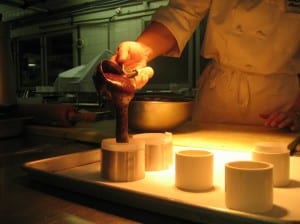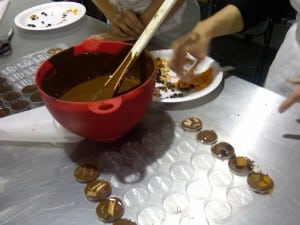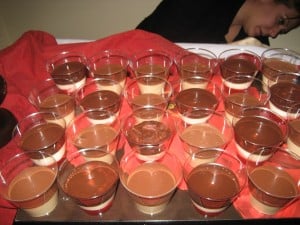Posts Tagged ‘chocolate and wine pairing’
Temper, Temper – Shiny Chocolate Needs a Temper
This a video from a TasteDC Exotic Chocolate Cooking Class with Rob Kingsbury discussing the tempering of chocolates. Tempering is a term both used in chocolate and in food preparation, but the word is used slightly differently for each purpose. In food prep, when you use the term “tempering”, it’s often associated with tempering eggs – if you add raw eggs to a hot liquid, they will scramble, which is usually not the goal, you want to incorporate eggs in an emulsion evenly throughout. Rob, who owns both ACKC on 14th St., in Washington, D.C. and Del Ray, VA, as well as Kingsbury Chocolates in Alexandria, VA, mentions how his mother made Chocolate Cream Pie by tempering eggs. When it comes to chocolate, tempering is about creating shiny hard chocolate which is snaps when you break it or bite into it. This is caused by the crystalline structure of the cocoa butter and solids together, for an intense explanation check out Cooking for Engineers on Chocolate Tempering. If you don’t temper chocolate, it just doesn’t have the appearance and crunch that most people like.
Here’s the information from the TasteDC class:
TasteDC’s Chocolate Temptation:
Class on Making Exotic and Unique Handmade Chocolates
with Rob Kingsbury, Kingsbury Chocolates
Sunday, March 26, 2006
Chocolate Menu:
-Chipotle Cinnamon Truffle
-Wasabi Orange Lavender Truffle
-Cosmopolitan Truffle
-Margarita Truffle
-Demonstration of a White Chocolate bar filled with Cranberry and Lime Relish.
Oh, and plenty of wine was served – Port and dessert wines go with chocolate, but medium bodied reds like Merlot do nicely.
Cheers!
Charlie “I Drink on the Job” Adler
Chocolate and Wine: A Pairing for Sweeties!
I love chocolate..I love wine..but can the two come together to make a great match? This is the dilemma of writing a chocolate and wine pairing article – it is not a “traditional” pairing, meaning, it is neither a regional pairing (Loire Valley Sauvignon Blanc and Chevre) nor a dish pairing such as steak and Cabernet Sauvignon. Chocolate and wine pairing was created primarily to satisfy the need for accentuating and justifying the obvious connection between being amorous and enjoying the sensual pleasures of chocolate and vino!
Actually, the pairing can work, so here’s my take on the combination. First, the assumption is you’ll be tasting dark chocolate, in other words, chocolate with say 60% or more Cacao percent. Dark chocolate or “bittersweet” chocolate has two components to think about: tannin (from the cacao bean) and sugar. The basics of food and wine pairing are either to pair similar or contrasting components. For example, since chocolate has tannin and red wine has tannin, you could pair those flavors. The effect of pairing similar tastes is actually to lessen each, also known as “1+1=1/2”. Take too similar “tastes” paired together and that component will be lessened. Tannin and tannin reduce the effects of each other. This same principle works with the sugar in chocolate and the sugar in a glass of wine, again the same thing, this will ultimately make both seem less sweet. This is a weird phenomenon, but try something basic like orange juice and a sweet morning muffin, and it becomes obvious.
If you contrast with your pairing, the most obvious is to pair a highly acidic wine with chocolate to counterbalance the tannin and/or sweetness. In my opinion, this won’t work very well because it would be an unnecessary overload of the senses. Plus, I’ve tried it, and it tastes pretty awful or neutral at best!
So you have a choice: you can either pair the sweetness with a dessert wine such as a French Sauternes or a German dessert Riesling or you can pair the tannin in chocolate with a red wine with tannin. For whatever reason, many Merlots and also fruity medium tannin wines work with chocolate. Merlot is generally medium tannin, but also has softer, lusher tannins that don’t seem to clash with chocolate.
So what’s my conclusion after evaluating the chocolate and wine pairing principles? Frankly, it’s better to just go with the romantic mood, forget the pairing and enjoy some delicious Champagne or sparkling wine with chocolate! My reasoning is the power of suggestion: sparkling wine suggests a special occasion, from the popping of the cork to the effervescence of the wine, and it promotes the romantic occasion.
You could play with the sparkling wine a bit by serving a Rosé which often is made from lightly pressed and fermented Pinot Noir. The best pairing might be Port which has both tannin from the red grapes as well as sweetness from sugar. My issue with Port is that from experience, many Americans aren’t fond of it, especially at tastings I’ve held, it is often over powering to an unaccustomed palate.
Conclusion: wine and food pairing shouldn’t get in the way of a romantic moment, they should accentuate it. Dessert wines work great with the sugar of chocolate, Port is even better, but medium tannin wines like Merlot also work well..still, Champagne or sparkling wine wines. Celebrate love and romance with a bottle of bubbly and share the moment!
What Wine Goes with PB&J?

They don’t stress much about drinking New Zealand wines in France – there is plenty of great wine in a French person’s backyard. So why is it Americans stress out so much about choosing the right wine with say a French dish like Ratatouille when a French wine from say the Languedoc would work fine? What is it as Americans that we expect from a wine and food pairing – a result of perfection where we can tell all of our compatriots how we successfully completed a veritably impossible task, matching the flavors of a dish with an unknown wine? Maybe we should study up on the world of wine, learn more about the intricacies of Gruner Veltliner from Austria and how it’s put this varietal on the map, or maybe we should read a few books on wine and food pairing to avoid that embarassing faux pas when we mistakenly ordered a Brut Champagne with our P,B &J when it should have been at least Extra-Dry or even sweeter? Oh, why can’t this be so much easier, why can’t they just put little labels on food telling us what goes and doesn’t go, why do we have to use our feeble brains??
That’s because the French eat French food everyday, and guess what wine they drink with it? French – their wine goes great with their dishes, eat up! This is all part of that horrifically difficult to explain “terroir”. Most of what you read and hear about terroir in wine circles relates to the location the vines were grown, but you rarely hear about the producer side of the equation, what I like to call “Pride in Ownership”. The tradition of drinking and eating local products created the pride in ownership that is part of terroir and what makes localities compete to make the best products. Just like a New Yorker will bitch to no end about how bad the bagels are outside of New York (must be the water?), a Frenchman will claim that their regions chevre (goat cheese) is better than even the neighboring villages. That cheese comes from a local goat, which was fed on local grasses and vegetation and its manure was used to fertilize the vines, or possibly it ate the weeds between the vines. The French drink French wine most of the time as do the Italians and the Spanish not only because it’s cheaper for them and readily available, but they connect emotionally with their own produced wine and cuisine. Being fussy about wine doesn’t make sense because it’s something consumed with everyday meals, normally lunch and dinner. You eat local and you drink local because you know what tastes best.
Americans are still developing our pride in our own products and sometimes it embarasses us – once I was at a French Burgundy wine tasting early in my career at TasteDC in Washington, D.C. and I mentioned half-jokingly that one of the wines might taste great with a good cheeseburger and french fries – I got a look like I had just committed a sacrilege! Wine was meant to be consumed with “real” food, not casual foods that were not worthy of their lofty reputations. I had offended the American luxury ethic – thou shalt not enjoy any luxury without tight-lipped apprehension – how dare I, Charlie Adler, a non-wine expert at the time, attempt to create an unofficial food and wine pairing! Call in an expert, food and wine pairing is rocket science, you need a degree in oenology even before you should be allowed to remove the cork!
OK, this seems a bit facetious, but if you had been consuming wine in the 90’s, you met quite a few people with sour puss demeanors. Even the idea that someone would pair wine with something as mundane as a sandwich, much less a PB&J was considered to be preposterous and very uncouth. Times have changed, wine is prevalent and available everywhere from supermarket and in some cases to the corner 7/11. You don’t need a degree to enjoy wine with food, just do what the French do – eat and drink local. So now that I’m serving Virginia ham with some local cheeses, I’ll choose a wine that..wait, isn’t ham salty and that will have a chemical effect on tannin? Well then, I better not choose a wine that’s too tannic, it will..
Charlie “I Drink On the Job” Adler
What Wine Goes with Chocolate?

Wander's Gooey Chocolate
I had a great Chocolate Making 101 class at Wander’s Chocolates in Manassas, Virginia this past Saturday. Lot’s of gooey chocolate and plenty of samples of ganache and a variety of top quality chocolates like Valhrona and El Rey. Chocolate is very much like wine – the location that the cacao pods are grown has a very noticeable effect on the final flavor and intensity of the final chocolate. Many processes occur to make your final chocolate such as conching, but much of the flavor as in red wine is from the concentration of flavor compounds in the pod – interestingly enough, these compounds are the same compounds that make both red wine and dark chocolate healthy for you. The reason milk chocolate and white chocolate aren’t quite as healthy for you is because they have other additives other than cacao.
So what wine goes with chocolate? The answer is a bit controversial because many wine tasters disagree what is a good pairing. I have always heard from wine pros that dessert wines and desserts go together, but personally, I think this is mostly wrong – for me, if I put a sweet dessert in my mouth and sip a sweet dessert wine, they really cancel each other out – I prefer dessert wines with salty foods, fatty foods (foie gras and Sauternes comes to mind) or just by themself.
Chocolate on the other hand has an earthy component (have you ever heard a wine described as having cocoa or mocha components?) that can pair well with earthy wines – and most earthy wines are red. The traditional pairing for chocolate is Port because it contains two excellent pairing components: it’s sweet to reduce th sweetness of the chocolate and its red with usually a bit of earth Portuguese red varietals that counterbalance chocolates cocoa components. In some ways the compounds from red wine skins match cacao flavors, and this makes the chocolate much less earthy. I’ve had many wines with chocolate, and I find that less complex reds like basic Italian Sangiovese (like Chianti) and Spanish Tempranillo often go really well. As in most food and wine pairing, simpler less concentrated wines with decent acidities tend to go better with food, while big trophy wines tend to be better without food – they show best on their own.
Originally, Montezuma allegedly drank 50 cups or so of cacao a day in order to keep his harem happy and to multiply. But the original cacao had no sugar, but was in fact mixed vigorously (frothed) with herbs, hot peppers and sometimes even mushed up corn. Chocolate was a savory beverage, and not until the Spanish brought it back to their country and added sugar to it, did it become closer to the “hot chocolate” that we know today – candy bar chocolate came much later. The point here is that chocolate is actually a savory item and that a nice red wine, even a Merlot can often go well. As I always say, food and wine pairing is not a science: taste, experiment and taste a variety of food and wine pairings until you find what you like. The good news too is that no one ever dies from a bad food and wine pairing, all you get is slightly less pleasurable or bad experience – but the fun is in the learning – cheers!
Charlie “I Drink On the Job” Adler








